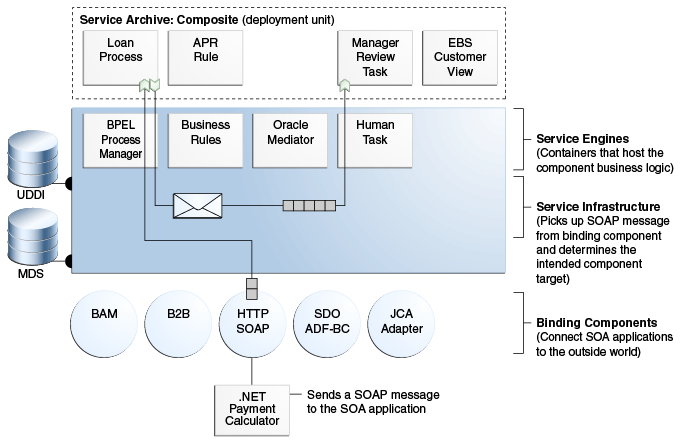Runtime Behavior of a SOA Composite Application
Figure 1-2 shows the operability of a SOA composite application using SCA technology. In this example, an external application (a .NET payment calculator) initiates contact with the SOA composite application.
For more information about descriptions of the tasks that services, references, service components, and wires perform in an application, see Service Component Architecture within SOA Composite Applications.
Figure 1-2 Runtime Behavior of SOA Composite Application

Description of "Figure 1-2 Runtime Behavior of SOA Composite Application"
The .NET payment calculator is an external application that sends a SOAP message to the SOA application to initiate contact. The Service Infrastructure picks up the SOAP message from the binding component and determines the intended component target. The BPEL process service engine receives the message from the Service Infrastructure for processing by the BPEL Loan Process application and posts the message back to the Service Infrastructure after completing the processing.
Table 1-2 describes the operability of the SOA composite application shown in Figure 1-2.
Table 1-2 Introduction to a SOA Composite Application Using SCA Technologies
| Part | Description | Example of Use in | See Section |
|---|---|---|---|
|
Binding components |
Establishes the connectivity between a SOA composite and the external world. There are two types:
|
The SOAP binding component service:
An example of a reference binding component in Figure 1-2 is the Loan Process application. |
|
|
Service Infrastructure |
Provides internal message transport |
The Service Infrastructure:
|
|
|
Service engines (containers hosting service components) |
Host the business logic or processing rules of the service components. Each service component has its own service engine. |
The BPEL process service engine:
|
|
|
Universal Description, Discovery, and Integration (UDDI) and MDS |
The MDS Repository stores descriptions of available services. The UDDI advertises these services, and enables discovery and dynamic binding at runtime. |
The SOAP service used in this composite application is stored in the MDS repository and can also be published to UDDI. |
|
|
SOA archive composite (deployment unit) |
The deployment unit that describes the composite application. |
The SOA archive (SAR) of the composite application is deployed to the Service Infrastructure. |